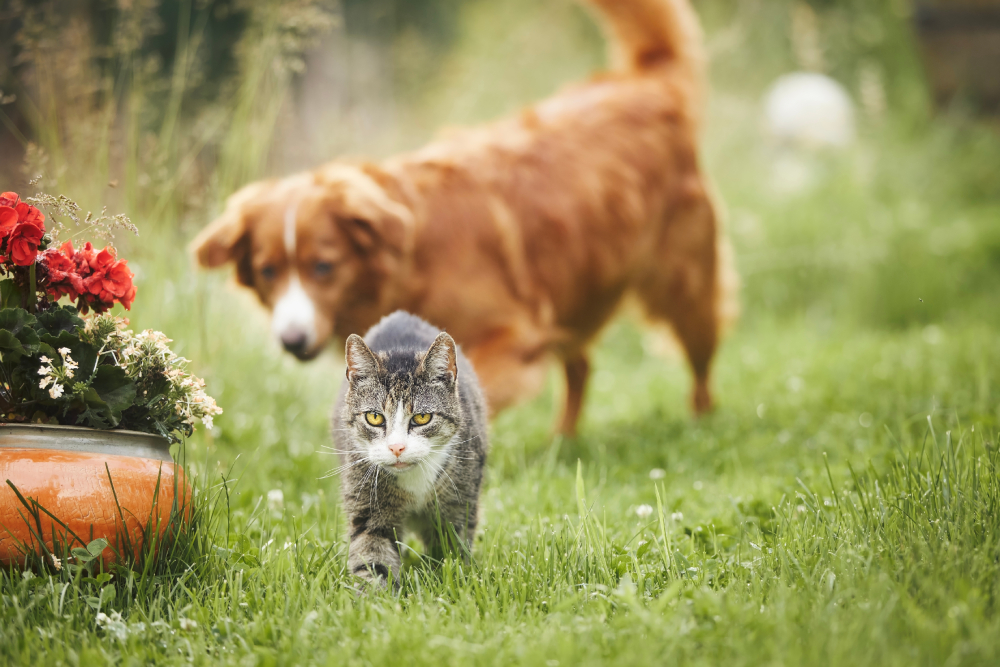
Dogs most often chase cats because they have a natural prey instinct, which means they will chase any smaller animal that runs. It isn’t necessarily an aggressive move, and the dog may want to play, but it can cause panic and anxiety in the cat. If it happens outside the home, the cat can get into trouble running on the road. If it happens indoors, it can cause serious anxiety in the cat, who can become afraid to even walk around their own home.
Just because it is a natural instinct for dogs to chase cats, doesn’t mean you have to put up with it. There are steps you can take to help train this behavior out of a dog, ensuring cats are safe and comfortable wherever they are.
Why Do Dogs Chase Cats?
It is natural for some dogs to chase cats. Some breeds are more prone to chasing than others, and, unfortunately, once the cat is startled or defensive, it is likely to run hard and further. This further excites the dog, who will see the whole thing as a challenge, and it could potentially put them both at risk.
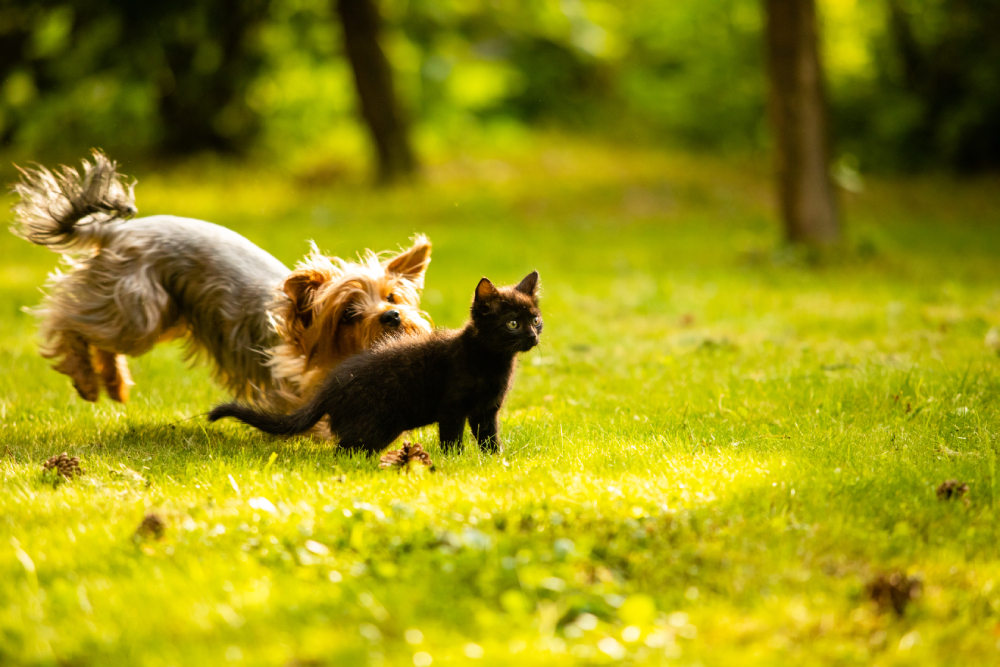
Prey
Dogs are, by nature, hunters. In the wild, they would hunt small animals, typically resulting in them chasing the prey until they caught it. While domesticated dogs don’t need to hunt anything more than a bowl for most of their meals, the prey drive is still present in a lot of dogs.
So, when your dog sees a cat, they might see it as potential prey. If the cat then runs, this further heightens the prey-drive instinct in your dog, who will naturally run after the cat. Even if your dog is reacting to its prey drive, it doesn’t necessarily mean that they are being aggressive. But it likely does mean that the cat is scared and anxious.
If the cat and dog don’t know one another, the cat will likely make its way home and potentially avoid the area. If it happens in the home, the cat doesn’t really have the same escape possibilities. If it keeps, it can cause your cat to become anxious. And anxiety leads to a host of mental and physical health problems.
Play
Some dogs have high play drives, rather than prey drives. If your pup loves chasing a ball or any toy that you kick around, there’s a good chance it will also enjoy chasing cats. Your dog probably knows that chasing after the cat encourages them to run, and then it all becomes a fun game of chase. To your dog, anyway. Your cat will see it differently, and it will likely cause you upset and worry.
How To Stop Your Dog Chasing Cats
Dogs chasing cats might be natural, but it can be dangerous for the dog, the cat, and anybody who gets in between them. Stopping this behavior is important.
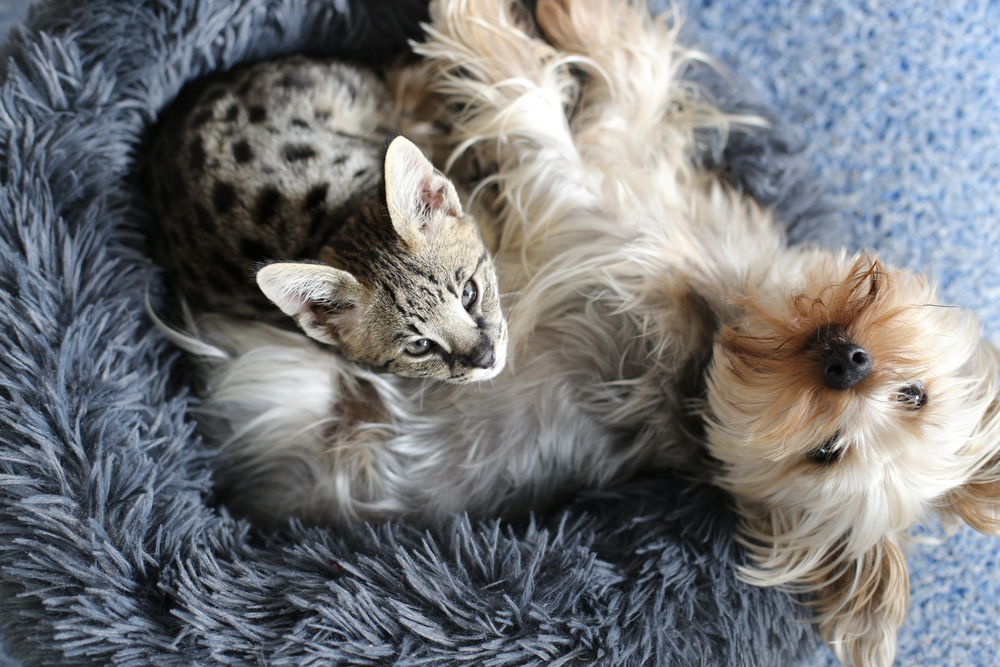
1. Supervision
If your dog is prone to chasing cats, ensure they are supervised around cats. This is true whether they’re at home or out of the house. If you’re around, you can identify the trigger, and spot when your dog is going to chase your cat. This way, you can take action to prevent it.
You should always be supervising your dog when out of the house, so this also allows you to take action before chasing becomes a problem.
2. Create a Safe Space
In the house, ensure your cat has safe spaces to escape to. Most cats are agile, and this means that yours will be able to hop up on surfaces out of the way of your dog. Consider putting cushions, blankets, and beds on top of drawers and cupboards.
If you’ve yet to introduce the dog and cat properly, consider a stairgate as a viable option.
3. Basic Commands
Every dog should learn basic commands. It will make both of your lives better, as well as those of the people and, in this case, cats around you. If you can get commands like sit, stay, and come, you will be able to use these to prevent your dog from chasing cats, in most cases.
This also helps establish a relationship between the two of you, where your dog listens to you and is more likely to do what you ask of them.
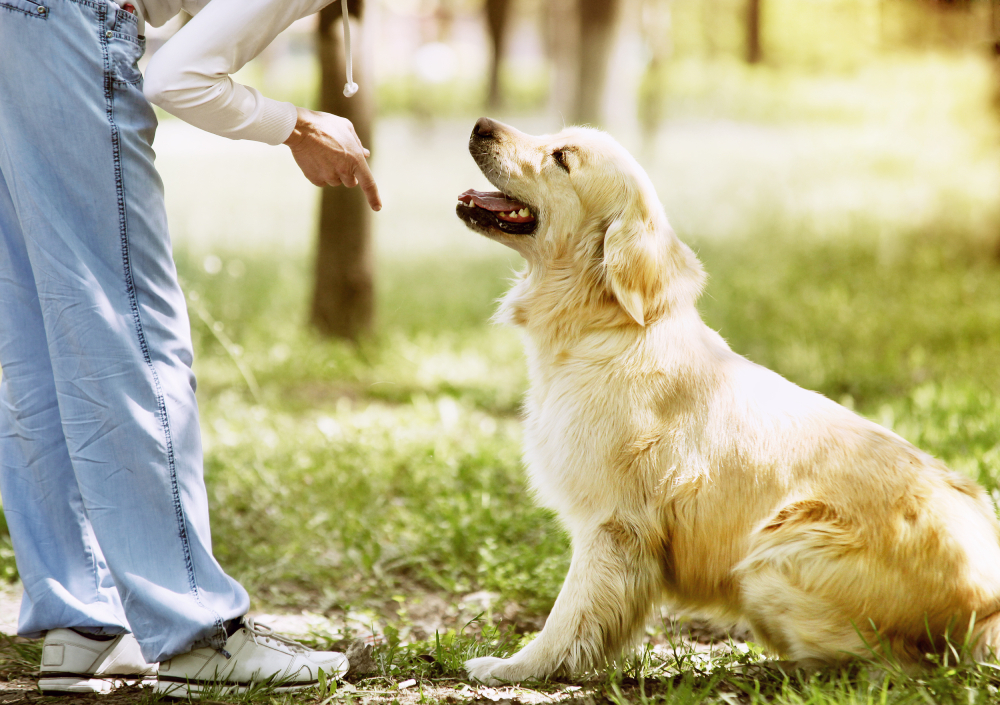
4. Distraction
Distraction is useful during training and when trying to stop dogs chasing cats. Training your dog to sit in a peaceful, calm environment is one thing. Having them sit when a cat runs past is another thing entirely. Have members of the family walk past or call while you’re doing your daily basic training.
See whether your dog still responds to your commands. You can make the distractions progressively louder before trying it out with a cat in the vicinity.
5. Introductions
When you first bring the cat or dog home, it is important to make proper introductions. These should be slow and gradual, and typically on the cat’s terms. Use a crate or stair gate as a physical barrier initially. A cat will be able to jump over the gate or approach the crate without fear of being chased. And, over time, you can remove this barrier, but only when the two have gotten used to the smell of one another.
6. Positive Reinforcement
When your dog is near a cat, make a noise or use a trained command to get their attention. When they pay you attention, rather than the cat, reward them with a treat and lots of praise. This positive reaction reinforces the good behavior that you want, and, in time, your dog will perform the desired action because they know that’s what you want.
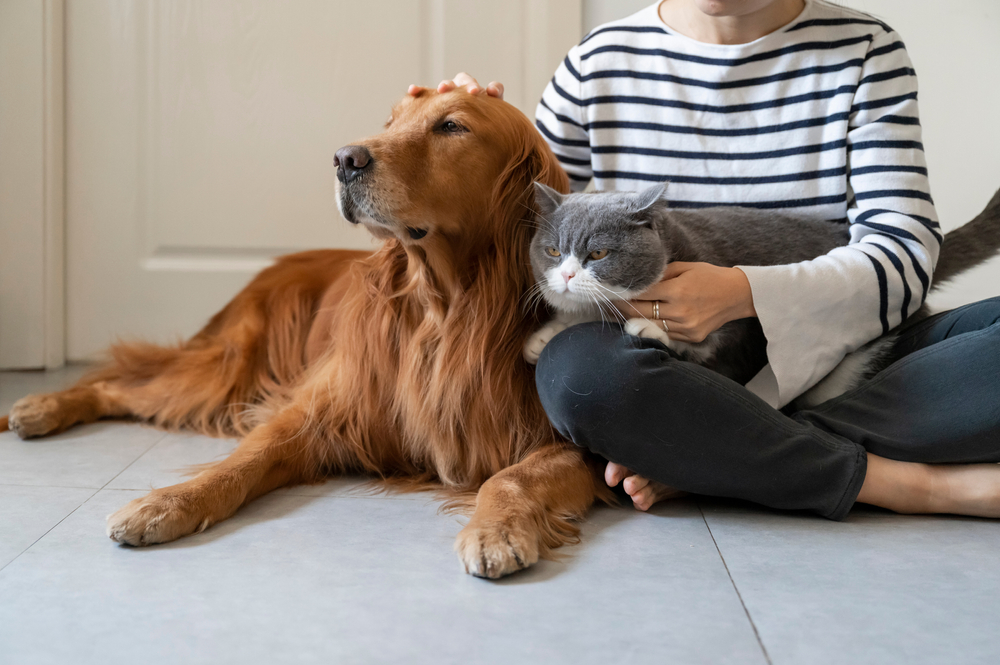
7. Consult a Behaviorist
If you’re struggling to control your dog around cats, or if your cats are getting anxious because the dog keeps chasing them, it is worth speaking to an animal behaviorist. They will be able to give you specific techniques that will help prevent the chasing.
They can also help with any other behavioral problems you might have.
What To Do If Your Dog Attacks a Cat
If the unthinkable happens and your dog attacks a cat, whether it is yours or somebody else’s, you need to take action to stop the attack.
1. Separate Them
Don’t put yourself directly between the cat and dog or you could get seriously injured. Instead, use an object. Close a door between them or move a chair in the way. This should give the cat a chance to escape, and it will enable you to get control of the dog.
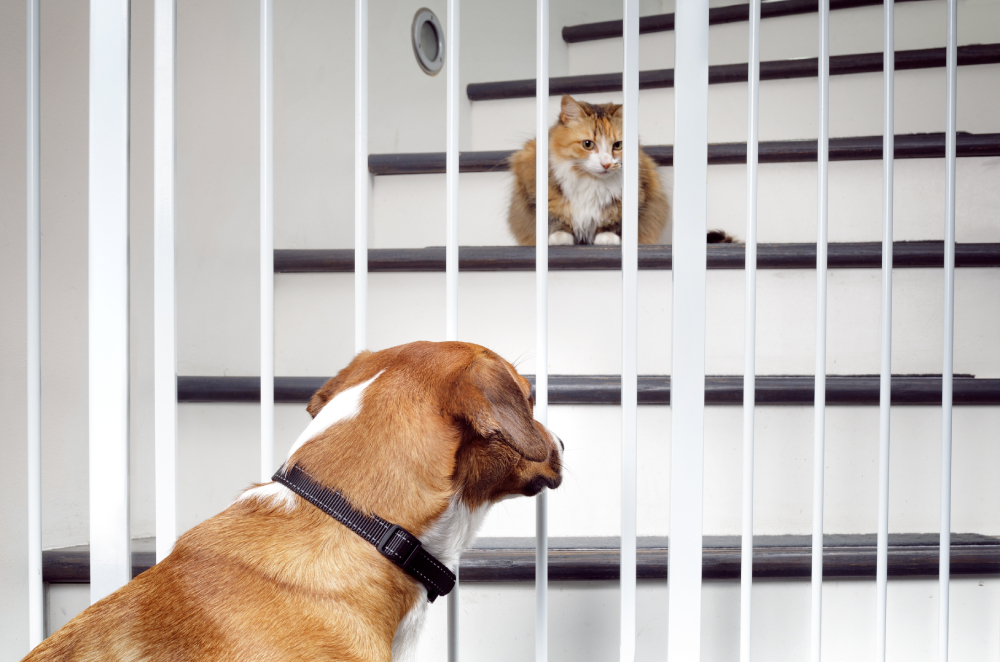
2. Check for Injuries
Check the cat for injuries first. It is the most likely to have suffered a serious injury. If the cat is fine, check the dog. While a cat is less likely to cause serious harm to a dog, a scratch or bite in the eye could cause serious injury. And, if your dog has an open sore, there is a risk of it becoming infected.
3. Consult a Trainer
If your dog has attacked a cat, you need to get professional help. Speak to an animal trainer or behaviorist. There are different options, including in-house behaviorists who will come to you to work on the problem. They will be able to identify the cause of the action and work with you to help overcome it.
4. Reintroduce the Dog and Cat
If there has been a setback in the relationship between your cat and dog, you will need to reintroduce them. This means starting again and taking introductions as slowly as you would if you were just bringing the dog home for the first time.
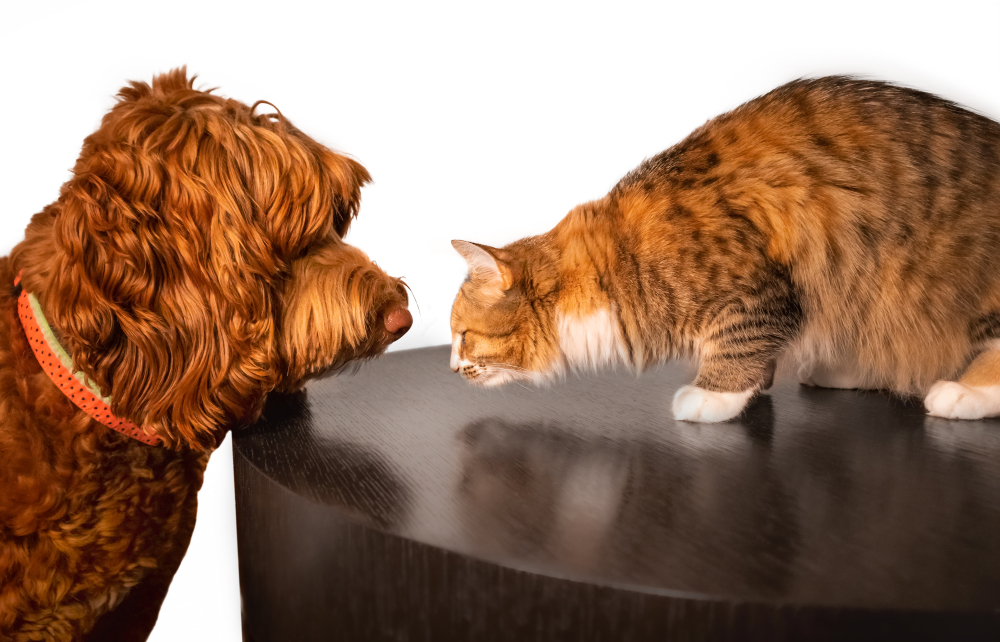
Frequently Asked Questions
Do You Need to Stop Your Dog Chasing Cats?
For a cat, being chased by a dog is a stressful experience, if it happens outside the house. If it happens inside the home, the cat can feel trapped and might start to suffer from anxiety.
It could even cause your cat to become more likely to wander or exhibit unwanted behaviors around the house.
Is It a Breed Thing?
Some breeds are indeed more prone to chasing cats than others. Breeds that were originally raised to hunt small animals are, unsurprisingly, those that are most likely to give chase when they see cats.
However, the character and traits of the individual dog are more likely to determine whether it chases cats than its breed.
Conclusion
It is natural for some dogs to want to chase cats. It harks back to the days when dogs would hunt for their own meals, or when they were raised to chase off or even hunt down small animals. But just because it is instinctive, doesn’t mean it’s a desirable trait. Nor does it mean that it is a behavior you have to put up with.
Use gentle introductions, good training, and positive reinforcement to help discourage your dog from chasing after your cat. And, if you’re still struggling to control the behavior, or it becomes serious, speak to an animal behaviorist.
Featured Image Credit: Jaromir Chalabala, Shutterstock
Credit : Source Post









